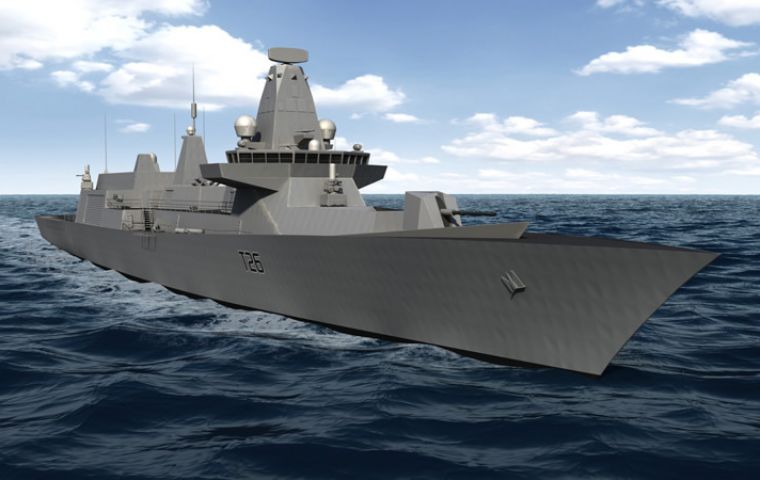MercoPress. South Atlantic News Agency
BAE yards threatened once Royal Navy carriers are delivered in 2018, warn unions
 The Type-26 frigate to replace the 13 Type-23 frigates dating to 1989, only begins in early 2020
The Type-26 frigate to replace the 13 Type-23 frigates dating to 1989, only begins in early 2020 Britain should bring forward orders for a new generation of navy frigates to help BAE Systems bridge a production hiatus that’s threatening its warship-making capabilities and 6.000 engineering jobs, the Unite union revealed.
Europe’s No. 1 weapons-maker said this month it had begun a study into future options for yards in Scotland and Portsmouth, once production slows with the completion of two Royal Navy aircraft carriers in 2018. The first Type 26 frigate isn’t due to be delivered until the early 2020s, leaving the sites dependent on support work and minor programs for foreign fleets.
“The government can’t expect a private company to keep thousands of people sweeping the floor or painting its workshops waiting for the work to come in,” Ian Waddell, Unite national officer for aerospace and shipbuilding, said in an interview. “It should bring the contract forward to span the gap.”
The situation has gained a political twist as the Scottish parliament moves to hold an independence referendum in 2014, Waddell said. Portsmouth would more likely be retained by the UK government in the event of a vote that would effectively place the two Glasgow yards in a foreign country, he said.
BAE Systems was already evaluating operations in response to falling defence budgets, and said last Sept. 27 it would cut 3.000 U.K. posts to trim costs and slow production of Euro fighter warplanes, having eliminated 15.000 positions globally in 2009 and 2010.
The appraisal will be in line with commitments given in a 2009 agreement with the UK government. That accord guarantees “minimum future work levels” over a 15-year-period while committing BAE to delivering “substantial” efficiency improvements, the Ministry of Defence said in an e-mail.
Construction of hull sections for the HMS Queen Elizabeth and HMS Prince of Wales aircraft carriers is being undertaken at BAE Scotstoun and Govan yards on the River Clyde in Glasgow and in Portsmouth, with the ships due to be assembled at Babcock International Group Plc dockyard in Rosyth, near Edinburgh.
An assessment of the Type 26 that began in 2010 won’t end before 2014, after which the government must sign off on the project before BAE can commence manufacturing. The first example will be delivered after 2020, though it’s “difficult to give an exact date” BAE said.
Ships will be built at a rate of about one a year, with a requirement for anti-submarine and general-purpose versions to replace 13 Type-23 frigates dating to 1989.
The frigate program could be accelerated by fixing the design as soon as possible and then eliminating the usual gaps between phases, cutting as much as two years from development and minimizing the lull between projects, Waddell said.
Export orders for the Type 26 could boost the production run, and the vessel is being pitched to foreign governments as the so-called Global Combat Ship. Britain has formally invited Brazil to become a partner in the program, and is looking at opportunities in Turkey and Malaysia, BAE said.
Still, some job cuts seem inevitable, because even bringing forward the Type 26 won’t compensate for the end of work on the carriers, Waddell said. The carriers are Britain’s biggest-ever warships at 920 feet long and 65.000 metric tons displacement.
“I can’t see how you can maintain that level of employment,” he said. “You’re going from two huge carriers to one relatively small vessel.”




Top Comments
Disclaimer & comment rules-

-

-

Read all commentsThe UK defence industry will have some interesting dilemmas re contract placement for warships, etc.
Jan 31st, 2012 - 11:43 am 0As England will have no interest in preserving employment in Scotland after independence, the Glasgow shipyards will have to pitch competitively for build projects against English yards.
There will certainly be no place for two Clyde shipyards, so there will inevitably be major job losses once Scotland becomes independent.
Still, England could treat the Scots a bit more like the Gurkas - the source of warriors; just like the English did with Irishmen in days of Empire.
This Article says :
Jan 31st, 2012 - 12:28 pm 0No:1Europe Weapon said this month it had begun a study into future
options for yards in SCotland and Portsmouth..........
I say :
When Scotland declares independence ,it is also likely that the UK will be forced to find a new place for its four Trident submarines which are based at Faslane ,around from 25 miles from Glasgow....!............
“the Glasgow shipyards will have to pitch competitively for build projects against English yards.”
Jan 31st, 2012 - 03:22 pm 0I don't think you've thought that through at all. The RN won't have another nation build it's ships. They'll just move the work down south.
I'd bet quite a few of the current ship workers would just move south if the work all moved with it.
Commenting for this story is now closed.
If you have a Facebook account, become a fan and comment on our Facebook Page!